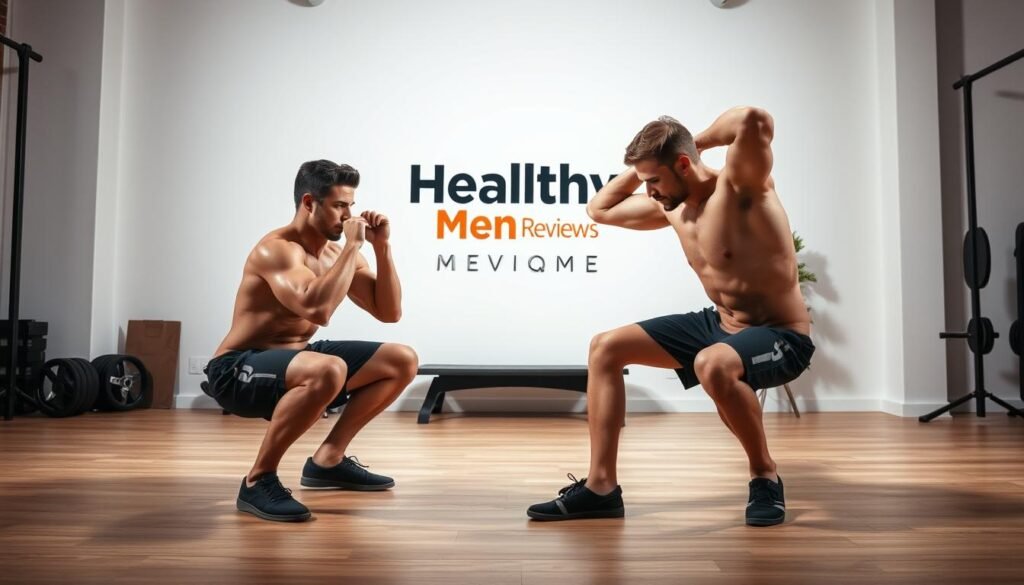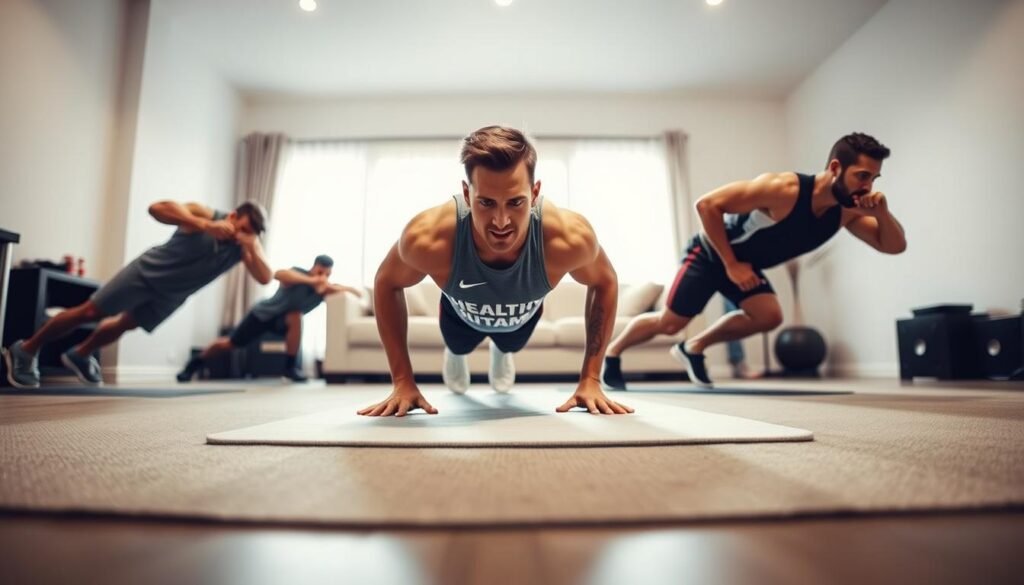As you get older, your body changes in many ways. After 30, it’s common to lose muscle mass. But, you can still regain or even build new muscle.
Maybe you’re wondering if you can still reach your fitness goals. The answer is yes! With the right steps, you can build muscle and boost your health. This article will show you how to start.
Key Takeaways
- Understand the importance of building muscle after 30
- Learn how to get started with muscle building
- Discover the benefits of maintaining muscle mass
- Explore effective strategies for building muscle
- Find out how to create a personalized fitness plan
The Physiological Reality: What Happens To Your Body After 30

When you reach your 30s, your body starts to change in ways that affect your muscles and fitness. These changes come from hormonal shifts and natural muscle loss. Both play big roles in how your body reacts to exercise and food.
Hormonal Changes That Affect Muscle Growth
Hormonal changes are key in muscle growth after 30. Two main hormones involved are testosterone and growth hormone.
Testosterone Decline and Its Impact
Testosterone levels start to drop slowly after 30. This drop can hurt muscle mass, as testosterone is key for building muscle proteins. A study in the Journal of Clinical Endocrinology and Metabolism showed a 10-15% testosterone drop per decade can really affect muscle growth.
Growth Hormone Production Changes
Growth hormone production also goes down with age, usually after 30. This drop can slow down muscle recovery and growth.
“Growth hormone is vital for muscle repair and growth. As we age, less growth hormone makes it harder to build and keep muscle mass.”
Natural Muscle Loss: Understanding Sarcopenia
Sarcopenia, or natural muscle loss, happens as people get older. Knowing about it is key to fighting it.
How Much Muscle Mass You Naturally Lose
Adults lose 3-8% of muscle mass every decade after 30. This loss speeds up after 60.
| Age Group | Average Muscle Mass Loss |
|---|---|
| 30-40 | 3-5% |
| 40-50 | 5-7% |
| 50-60 | 7-8% |
Why Prevention Starts Now
Stopping muscle loss needs action now. Regular strength training and a balanced diet can help fight sarcopenia. Starting in your 30s can greatly improve your muscle health as you age.
Why Building Muscle Matters After 30 — And How To Get Started

When you reach your 30s, building muscle is more than a fitness goal. It’s a key step towards a healthier, more vibrant life. At this age, your body changes in ways that affect your muscle mass and health.
Health Benefits Beyond Aesthetics
Building muscle after 30 brings many health benefits. These benefits can greatly improve your quality of life.
Metabolic Advantages and Weight Management
More muscle means a faster metabolism. This makes it easier to keep a healthy weight and body shape. It also helps with glucose metabolism.
Longevity and Quality of Life Improvements
Resistance training and muscle building can make you live longer. They also lower the risk of chronic diseases. This leads to a more energetic and independent life as you age.
Setting Realistic Expectations For Your Fitness Journey
When starting your muscle-building journey, set realistic goals. Know your current fitness level and health status. This helps create a better training plan.
Timeline for Visible Results
Seeing muscle-building results takes time, often weeks to months. Stay consistent and patient.
Adjusting Goals Based on Your Starting Point
Your fitness level and health status affect your muscle-building goals. Adjust your goals to stay motivated and track your progress well.
Debunking Myths: Can You Really Build Significant Muscle After 30?
Many think muscle growth stops at 30. But, research proves this isn’t true. With the right plan, you can still grow muscle.
Success Stories And Scientific Evidence
Many success stories and studies show muscle building is possible after 30. Resistance training works well for older adults.
Research on Muscle Growth in Middle Age
Studies show middle-aged people can gain a lot of muscle and strength. A Journal of the American Medical Association study found that resistance exercise greatly improves muscle mass and function.
Adjusting Your Mindset For Long-Term Success
To succeed in building muscle after 30, change your mindset. Focus on consistency over intensity. Regular workouts and gradual increases are key, not pushing too hard.
Consistency Over Intensity
Consistent training and slow progress lead to lasting muscle growth. This method keeps you motivated and avoids burnout.
Creating Your Muscle-Building Foundation: Essential Equipment And Space
Starting your muscle-building journey after 30 is exciting. It’s important to set up the right foundation. This means choosing the right equipment and space for your workouts.
Home Gym Basics Vs. Gym Memberships
Deciding between a home gym and a gym membership is a big first step. Both have their good points and bad points.
Cost-Benefit Analysis for Your Situation
Think about the costs of each choice. A home gym costs money upfront but saves money later. Gym memberships give you flexibility and access to many machines, but they can get expensive.
Minimal Equipment Options For Maximum Results
You don’t need a lot of equipment to start muscle building exercises for beginners. There are simple options that can give you great results.
The Only Five Items You Really Need
Start with these essential items:
- A good quality adjustable dumbbell
- A resistance band
- A pull-up bar
- A stability ball
- A kettlebell
These items let you do many exercises that work different muscles. They’re key for a successfulbest workout routine for over30s.
The Optimal Workout Structure For Muscle Growth After 30
Building muscle after 30 requires a well-structured workout plan. As you get older, your body changes how it responds to exercise. You need to adjust your training to get the best results.
Frequency: How Often Should You Train?
How often you train is key to building muscle. Adults over 30 should aim for 3-4 times a week for each major muscle group. This balance helps your muscles grow and recover well.
Finding Your Recovery Sweet Spot
Recovery is just as important as working out. Make sure you give your muscles enough time to rest between sessions. This includes rest days, good sleep, and proper nutrition.
Volume And Intensity: Finding Your Sweet Spot
The volume and intensity of your workouts matter a lot. For adults over 30, aim for a moderate to high volume with a focus on intensity. Try 3-4 sets per exercise with 8-12 reps.
Progressive Overload Principles for Adults
Increasing the weight you lift over time is crucial for muscle growth. Adults can increase the weight by 2.5-5lbs every two weeks. Or, whenever you feel you can lift more.
Rest Periods: The Forgotten Growth Factor
Rest periods between sets and workouts are vital for muscle recovery and growth. For hypertrophy training, rest for 60-90 seconds between sets.
Optimal Rest Between Sets and Workouts
The rest time between workouts depends on the muscle group. For example, legs and back need more time (48-72 hours) than arms and shoulders.
| Component | Recommendation | Benefits |
|---|---|---|
| Training Frequency | 3-4 times per week per muscle group | Adequate stimulation and recovery |
| Volume and Intensity | Moderate to high volume, 8-12 reps | Effective muscle growth |
| Progressive Overload | Increase weight by 2.5-5lbs every two weeks | Continuous muscle challenge and growth |
| Rest Periods | 60-90 seconds between sets | Optimal recovery for hypertrophy |
Key Exercises That Deliver The Best Results For Adults Over 30
Building muscle after 30 starts with knowing the best exercises for your age. As you get older, your body changes in ways that affect muscle building. Choosing the right exercises is key to reaching your fitness goals.
Compound Movements: The Foundation Of Your Routine
Compound movements work many muscles at once. They are great for building strength and muscle quickly. For those over 30, adding these exercises to your routine is vital.
The Big Five Movements You Need
- Squats: Works your legs, glutes, and core.
- Deadlifts: Targets your back, legs, and glutes.
- Bench Press: Focuses on your chest, shoulders, and triceps.
- Rows: Works your back, shoulders, and arms.
- Presses: Targets your shoulders and triceps.
Isolation Exercises: When And How To Incorporate Them
Isolation exercises target specific muscles. They are good for fixing weak spots or imbalances. Knowing when to use them is crucial after 30.
Targeting Weak Points Effectively
Find areas needing work and use isolation exercises like bicep curls or tricep extensions. This will help you achieve a balanced look.
Joint-Friendly Alternatives To Traditional Exercises
As you age, your joints may get more injury-prone. Changing traditional exercises to be easier on your joints can help. This way, you can still build muscle without harming your joints.
Modifications That Prevent Injury
For instance, try bodyweight squats or use a leg press machine instead of regular squats. These changes reduce joint stress while still working the right muscles.
Adding these exercises to your routine will help you build muscle effectively after 30. Always listen to your body and adjust your routine as needed.
Nutrition Strategies To Support Muscle Growth In Your 30s And Beyond
To build muscle in your 30s, knowing the right nutrition is key. As you get older, your body changes, making good nutrition essential for fitness.
Protein Requirements: How Much Do You Really Need?
Protein is vital for muscle growth. After 30, your body needs enough protein to fix and build muscle. Aim for 1 gram of protein per pound of body weight each day.
Age-Specific Protein Calculations
Over 30, you might need even more protein. Studies say up to 1.6 grams per kilogram of body weight could help. For example, if you weigh 150 pounds, you’d need about 110 grams of protein daily.
“Adequate protein intake is crucial for muscle repair and growth, even as you age.”
Caloric Surplus Vs. Body Recomposition
To grow muscle, you need to eat more calories than you burn. But don’t overeat. A small surplus is better and healthier.
Strategic Eating for Your Body Type
Knowing your body type helps plan your diet. Ectomorphs need more calories to gain muscle, while endomorphs should watch their calorie intake to avoid too much fat.
“The key to successful muscle building is not just about eating more, but eating smart.”
Meal Timing And Frequency For Optimal Results
When and how often you eat affects muscle growth. Eating protein and carbs before and after workouts boosts performance and recovery.
Pre and Post-Workout Nutrition Windows
Eat a balanced meal with protein and carbs 1-2 hours before working out. After, eat a mix of protein and carbs within 30-60 minutes to help with recovery and muscle growth.
By following these nutrition tips, you can support your muscle-building goals well into your 30s.
Recovery Becomes King: Why Rest Is Critical After 30
After 30, rest and recovery are key for building muscle. Your body recovers slower from workouts as you age. This isn’t just feeling tired; it’s about how your muscles grow and repair.
Sleep Quality And Muscle Growth: The Direct Connection
Sleep is when your body repairs and builds muscle. Deep sleep cycles release growth hormones. Poor sleep can slow muscle growth and increase injury risk.
Optimizing Your Sleep Environment
To sleep better, make your bedroom cool, dark, and quiet. Choose a comfy mattress and pillows. Use blackout curtains or a white noise machine if needed. Avoid screens before bed to help your body make melatonin.
Active Recovery Techniques To Accelerate Results
Active recovery is as crucial as rest. Foam rolling, stretching, and light cardio boost blood flow. This helps remove waste and improves future workout performance.
Mobility Work and Light Activity Options
Yoga or Pilates can improve your range of motion and reduce muscle tension. Walking or cycling promotes blood flow without straining your muscles. These activities are great for rest days or after strength training.
Overcoming Common Obstacles To Building Muscle After 30
As we age, our bodies change, making it harder to build muscle. But, with the right strategies, we can overcome these challenges. Building muscle after 30 is a journey that needs a good workout plan and the ability to face common obstacles.
Time Management Strategies For Busy Adults
Finding time to work out is a big challenge for adults over 30. Work, family, and social life can make it hard. Efficient time management is key. Try waking up earlier or using your lunch break for a workout.
Efficient Workout Formats for Limited Schedules
High-Intensity Interval Training (HIIT) is perfect for those with little time. It involves short, intense exercises followed by brief rests. This method saves time and is great for burning fat and building muscle.
- 20-minute HIIT sessions, 3 times a week
- Compound exercises like squats, deadlifts, and bench press
- Minimal rest between sets to maximize efficiency
Dealing With Injuries And Joint Pain
Injuries and joint pain are common, more so as we age. It’s important to listen to your body and not push through pain. Instead, focus on injury prevention and recovery.
Prehab Exercises That Prevent Common Issues
Prehab exercises strengthen muscles around joints, preventing injuries. Include exercises for your core, shoulders, and knees.
- Core strengthening exercises like planks
- Shoulder mobility exercises
- Knee strengthening exercises like leg press
Maintaining Motivation When Progress Slows
Progress may slow down with age, but don’t give up. Maintaining motivation is key. Set realistic goals and celebrate small victories.
Mental Strategies for Long-Term Adherence
Staying motivated requires a strong mental game. Consider keeping a workout journal or finding a workout buddy. These can help keep you on track and motivated.
“You don’t have to be great to start, but you have to start to be great.” – Zig Ziglar
By using these strategies, you can overcome obstacles to building muscle after 30. It’s about being consistent, patient, and willing to adjust your approach as needed.
Tracking Progress: How To Measure Success Beyond The Scale
To see how you’re doing, look beyond the scale. Weight is important, but it’s not everything. Your body composition, strength, and health are key too.
Starting your fitness journey means finding the right ways to track your progress. This keeps you motivated and helps you tweak your workout and diet.
Body Composition Measurements That Matter
Knowing your body composition is key. It shows your muscle, fat, and bone health. This info helps you tailor your fitness and diet plans.
Tools and Techniques for Accurate Assessment
There are many tools for measuring body composition:
- Dual-Energy X-ray Absorptiometry (DEXA)
- Hydrostatic Weighing
- Air Displacement Plethysmography (Bod Pod)
- Skinfold Measurements
- Bioelectrical Impedance Analysis (BIA)
| Method | Accuracy | Cost |
|---|---|---|
| DEXA | High | Moderate to High |
| Hydrostatic Weighing | High | High |
| Bod Pod | High | High |
| Skinfold Measurements | Moderate | Low |
| BIA | Moderate | Low to Moderate |
Strength Benchmarks To Aim For
Tracking your strength is vital. It’s about setting and reaching realistic goals.
Age-Appropriate Goals for Different Lifts
Choose strength goals that fit your age. For example, a 30-year-old beginner might aim to squat 1.5 times their body weight. More experienced lifters can aim higher.
“The only bad workout is the one that didn’t happen.” – Joe Cirulli
As you get stronger, check your strength often. Adjust your training to keep making progress and avoid plateaus.
Conclusion: Your Roadmap To Building Muscle After 30
Now you know about the changes after 30 and why building muscle matters. You’ve learned about the key equipment, workout structure, and nutrition for muscle growth.
To build muscle after 30, focus on big exercises and add smaller ones when needed. Make sure to rest well and eat enough protein and calories. Use body measurements and strength tests to track your progress.
Follow these tips and stay committed to your fitness journey. You can overcome challenges and see great results. Start building muscle today for a stronger, healthier you.
Starting muscle building after 30 needs patience, dedication, and the right advice. This roadmap helps you make smart choices and control your fitness path.

